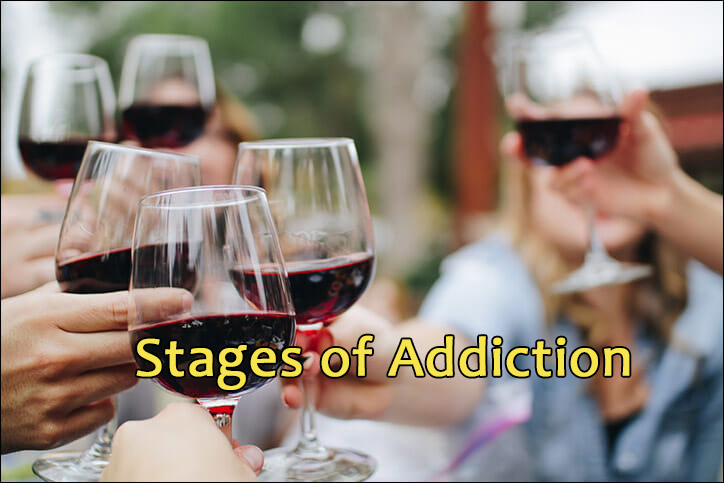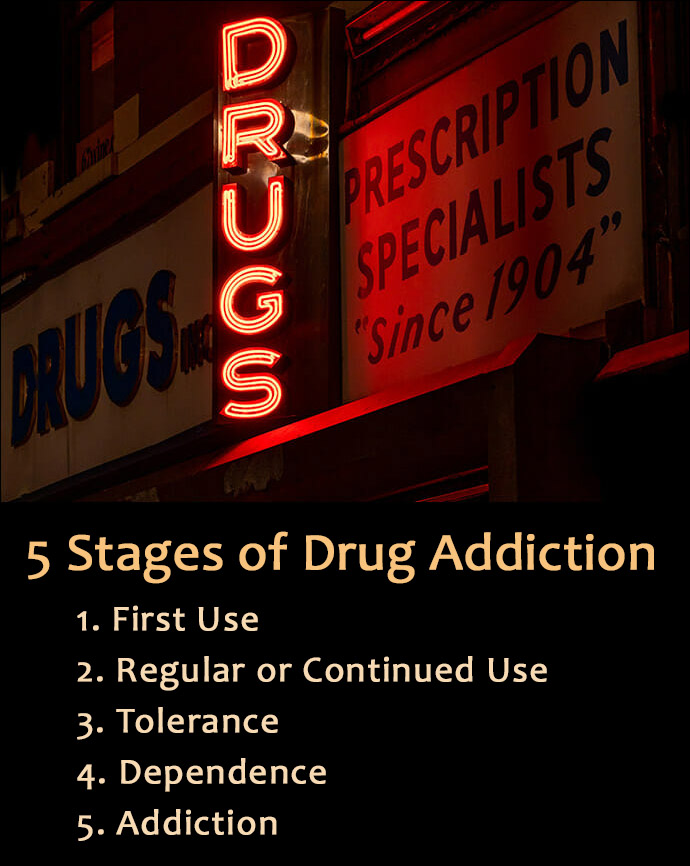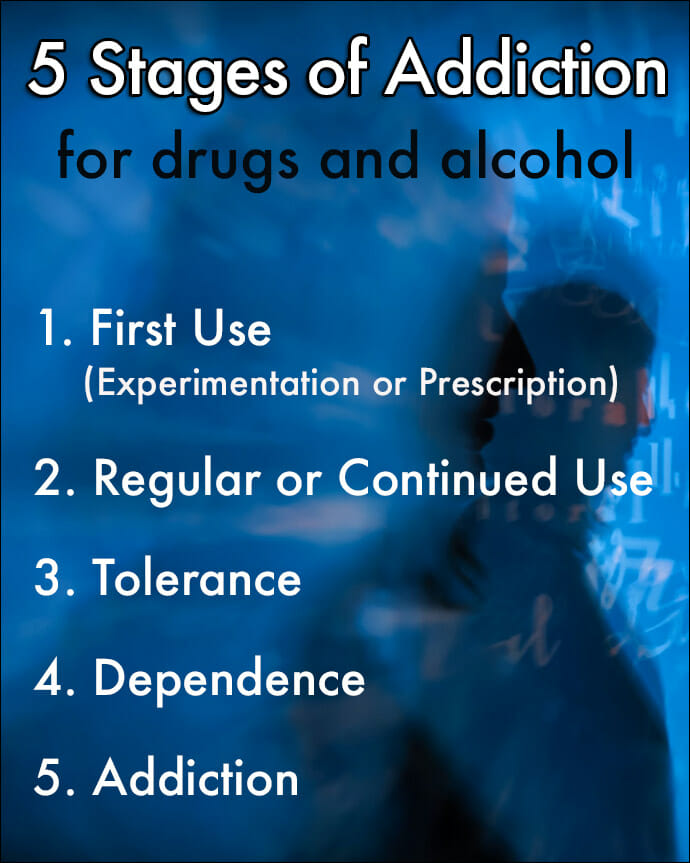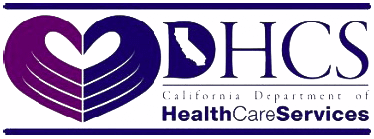Table of Contents
Addiction, like other chronic, relapsing diseases, follows a progression. That’s not to say each person’s experience is exactly the same, because it’s not. However, in breaking down the development from beginning to disease, most experts agree there are 5 stages of addiction.
This should not be confused with the transtheoretical model of change that outlines the stages of change a person experiences through addiction recovery.
When considering the stages of addiction, most people usually think about drugs and alcohol, or possibly nicotine.
It’s important to remember that other behaviors like eating disorders, gambling, and even smartphone use can share similar hallmarks of substance addiction, though usually not with the same health consequences.
While it’s impossible to pinpoint exactly how many people in the United States suffer from a substance use disorder, the National Survey on Drug Use and Health (NSDUH) estimates that it’s around 20 million people.
Unfortunately, this number is most likely underreported and might actually be much higher.
Stages of Addiction – NIDA Definition
According to the National Institute on Drug Abuse, NIDA defines addiction as:
“A chronic, relapsing disorder characterized by compulsive drug seeking and use despite adverse consequences. It is considered a brain disorder, because it involves functional changes to brain circuits involved in reward, stress, and self-control. Those changes may last a long time after a person has stopped taking drugs.”
Addiction progression is considered a complex brain disorder as well as a mental illness that develops over time and is marked by long-lasting changes to the brain’s chemistry.
“Addiction is the most severe form of a full spectrum of substance use disorders, and is a medical illness caused by repeated misuse of a substance or substances,” reports NIDA.
People battling addiction are criticized for compulsive drug seeking behavior and continued use despite incredibly damaging, and even life-threatening consequences.
Unfortunately, many people don’t realize when they have developed a mental or physical dependence on a drug or alcohol. They become physically and mentally incapable of stopping their behavior without intervention and treatment.
This is why it is so important to examine and understand the progression and stages that ultimately lead to addiction.
What are the 5 Stages of Addiction?
The 5 stages of addiction follow a progression that includes:
- First Use
- Regular or Continued Use
- Tolerance
- Dependence
- Addiction
The root cause of addiction, while not entirely understood by science, has generally been narrowed down to a combination of:
- Genetics
- Family History
- Environmental Issues
People who have suffered trauma, especially early childhood trauma, are particularly at-risk.
Because each person’s circumstances and substance use will be unique, there is no way to set a definitive roadmap or timeline each person will travel along the road to addiction, although the five stages outlined here generally apply to most people.
It should be noted that the stages of drug addiction are nearly identical to the stages of alcohol addiction with the possible exception of “Stage 1 – First Use.“
This is because not all people with an alcohol use disorder started using a prescription for alcohol, like with other medications.
The 5 Stages of Addiction
1. The First Stage of Addiction – First Use (Experimentation or Prescription Drug Use)
In the first stage of addiction, a person is experiencing his or her first physical and psychological encounter with how alcohol, an illicit drug, or even a medically prescribed drug makes them feel.
First use can be under any circumstance, like a teenager drinking or smoking pot at a party, or a person who became injured at work that takes a prescription opioid painkiller while recovering from their injury.
During the first stage of addiction, there are generally no negative consequences.
What is subconsciously registered though, is the seemingly positive change in the way a person feels when using the substance.
This sensation can be a variety of things, such as decreased physical or emotional pain, a feeling of peacefulness, euphoria, or a welcome numbing to social anxiety or pressure.
Many people mistakenly consider the first stage of addiction only as “experimentation” and they fail to consider that a large number of people have no interest whatsoever in experimenting with drugs or alcohol.
Other people experience their first encounter with addictive drugs as a medically necessary prescription medication from their own doctor.
They have no idea that they may one day become dependent or addicted to the drug.
2. The Second Stage of Addiction – Regular or Continued Use
The second stage of addiction is sometimes referred to as the “misuse stage,” although that might not necessarily be true for a person prescribed a potentially addictive sedative or painkiller.
The term “regular or continued use” is more fitting and accurate for the second stage of addiction. In this instance, a person’s prescription may require them to keep using the drug, at least for a period of time.
Sadly for some, that requirement might also be transforming into a physical and psychological desire to take the drug even after the prescription comes to an end and is not medically necessary any more.
For others, continued use is the return to a substance either immediately after first use, or even days, weeks, or months later because they liked the way they felt that first time.
As regular use becomes the norm, a person in this stage might notice that it takes longer for them to recover from a night out drinking, or from continued prescription drug use.
This occurs because it takes the body and brain a greater amount of time to repair itself from the buildup of chemicals in the system.
For many people, stage two of addiction can last years, or even a lifetime, without serious outward consequences, despite it being physically and mentally unhealthy.
This can be particularly frustrating for others who start to experience negative consequences relatively quickly. They may compare themselves to others, wondering why some people can drink or do drugs without any perceived issues.
3. The Third Stage of Addiction – Tolerance
Beginning with the third stage of addiction, after some time of regular and continued use, the body and brain become accustomed to drugs and alcohol. This is known as a tolerance.
A person starts to take more of the substance so he or she will experience the same type of mental and physical reward or escape they felt during the first use stage.
In many cases, people may not even notice that they are drinking more alcohol or using higher doses of drug or medication.
Some individuals, especially those developing a tolerance to a prescription painkiller, may immediately recognize that their normal amount of medication is not “working” like it once was.
A person with a high tolerance to a substance will need more of it to feel the effects.
But in the case of alcohol, an individual’s blood alcohol content will still register as legally intoxicated after the same number of drinks they consumed in stage one or two. They simply won’t “feel” like they are drunk.
Building a tolerance to addictive substances, whether alcohol or prescription medications, is an early and clear warning sign of addiction.
4. The Fourth Stage of Addiction – Dependence
The fourth stage of addiction is known as dependence, and is often confused with addiction. While that’s understandable, it’s not necessarily the same thing.
Here, a person’s life may still seem quite functional, though in reality they might have shaped their day-to-day routine around being able to use drugs or alcohol while still meeting some of their responsibilities.
This exemplifies a functional alcoholic or a closet drinker.
It’s a tricky balance in this stage because the dependence often also becomes physical. That means when going too long without a particular drug or alcohol, a person may start to experience physical withdrawal symptoms.
Stage four is characterized by a person that only feels normal or functional while under some level of intoxication from drugs, alcohol, or prescription medications.
5. The Final Stage – Addiction
The fifth stage of addiction occurs when addiction actually appears. This is the stage that experts refer to as “the full spectrum of substance use disorders,” where without intervention, help, and treatment, impulse control is impossible.
While some people who become addicted to drugs or alcohol can recognize the damage the disorder is causing to themselves and their loved ones, others may be in utter and complete denial.
Many people struggling with addiction may blame their family or society for the bad things that happened to them and those around them.
It can also be incredibly difficult for a person in this stage to seek help on their own because they are unable to envision a life without alcohol or drugs.
Even during forced sobriety, like being thrown in jail, the mental and physical cravings created by changes in the brain will send a person right back into drug or alcohol use when they get out.
In many circumstances, a person’s substance use becomes even worse than before, and the only way out is by recovering through an addiction treatment program.
Treatment for the Stages of Addiction
Understanding and being aware of the 5 stages of addiction is useful for recognizing risky behavior in others. It’s also necessary for identifying one’s own personal patterns that may prove troublesome if not addressed in the early stages.
That said, a patient in stage five is certainly not a lost cause and not suffering from a moral weakness or a lack of willpower.
They are battling a complex brain disorder and mental illness that it is possible to recover from through compassion, understanding, and evidence-based treatment methods.
The first phase of addiction treatment often begins with drug and alcohol detox. The detox process rids the body of the harmful effects of drugs or alcohol, while at the same time monitoring the person to make them safe and comfortable during the withdrawal symptoms.
After the withdrawal symptoms have subsided and the detox process has been completed, the next step is a formal addiction treatment recovery program.
Addiction treatment comes in many forms depending on the type of substance used, as well as the amount and duration of a person’s use.
Some people choose to follow the Twelve Steps of Alcoholics Anonymous, while others prefer an evidence-based approach used in many residential non 12 step rehab programs.
For those who began using drugs or alcohol as a way to cope with a mental health condition like depression, they may require a specialized recovery program known as dual diagnosis treatment that focuses on both issues at the same time.
Dual diagnosis treatment identifies and works to overcome the co-occurring disorders of addiction and mental health together.
Everyone should understand that there are 5 stages of addiction, it is a treatable health condition, and a person does not necessarily need to be in stage five to benefit from treatment.
In fact, early intervention at any stage can help an individual avoid extremely serious consequences that may occur somewhere down the road at any time in the future.
Stages of Addiction FAQs
What are the stages of heroin addiction?
The stages of heroin addiction follow the same stages of opiate addiction, alcohol, and other drugs, but often with one notable exception.
It’s common for people with any kind of opiate addiction to begin their path to addiction after being prescribed painkiller medication from a doctor.
They often don’t begin experimenting with drugs like people do without alcohol, marijuana, or other substances. They are given a legal prescription by a doctor to manage pain related to an injury or surgery.
Opioids are highly addictive, and many people quickly develop a dependence to them. When the prescription runs out, they look for other ways to get the drugs.
If they continue using them for an extended period of time, they build a tolerance that requires stronger opioids to achieve the same feeling as when they first started using them.
Heroin is cheaper and more potent than painkillers on the street. But once a person begins using it regularly, it becomes extremely dangerous and difficult to quit without professional treatment.
How can I identify if someone is progressing through the 5 stages of addiction?
When a person first begins using drugs or alcohol, there will not be any signs of addiction during the first stage of use.
Over time, the following signs follow a typical progression through the five stages of addiction:
- Repeated use
- Craving drugs or alcohol
- Increasing the amount used because of a tolerance
- Neglecting work, school, or other responsibilities
- Avoiding family and friends to get high
- Lying about using substances
- Financial problems due to drug or alcohol use
- Changes in personality, appearance, and health
- Inability to stop using drugs or alcohol
- Experiencing blackouts or withdrawal symptoms
These are general signs that will be different for each person, although many or all of them may appear at some point as substance use progresses to addiction.
How long does it take to progress through all the stages of addiction?
Progression through the stages of addiction will vary for each person, substance, frequency of use, and amount used. There is no set schedule or timeframe that will apply to everyone.
Some people may take a long time, and others will never become addicted.
First use to dependence and addiction usually proceeds more quickly with opioids than other substances. This can happen in a matter of weeks or months.
With alcohol, marijuana, and other drugs, dependence and addiction will often occur gradually, over many months or years.
Identify and recognizing the signs of addiction is necessary for seeking help and beginning recovery.
How does relapse fit into the 5 stages of addiction?
Some addiction models consider relapse as the 5th stage of addiction, because they consolidate tolerance and dependence into one stage, with addiction being the 4th and relapse as the 5th stage.
Addiction is defined as a chronic, relapsing disorder, so relapse should always be recognized as an important part of the process.
The transtheoretical model addresses the stages of change an individual experiences during the recovery process. After the last stage, addiction is either terminated and a person stops using substances, or they relapse, and the cycle of addiction begins again.
Relapse prevention is a necessary and vital part of addiction treatment, with the goal of successfully managing triggers and cravings to avoid using drugs or alcohol again.





